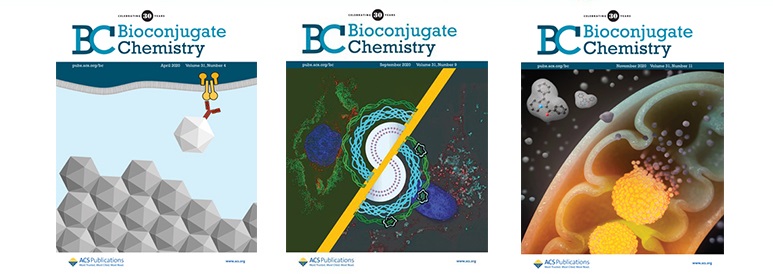
Three reviews by NMIN researchers – Drs Pieter Cullis, Shana Kelley, Dominik Witzigmann, and Gang Zheng – have been honoured with inclusion in 30th anniversary issues of the journal Bioconjugate Chemistry.
“Throughout 2020, Bioconjugate Chemistry is holding a year-round celebration with a special group of invited review authors,” comments NMIN researcher Dr. Gang Zheng, who is an Associate Editor of the journal. “All invited review articles published in this year will have the ‘30th Anniversary Review’ designation.”
Dr. Zheng is senior author of one such review: “Activating Drugs with Sound: Mechanisms Behind Sonodynamic Therapy and the Role of Nanomedicine,” featured in Issue 4 of the anniversary run (Volume 31).
In the paper, Dr. Zheng and colleagues critically assess the proposed mechanisms involved in Sonodynamic therapy (SDT), a promising platform for minimally invasive cancer treatment which uses deep-tissue-penetrating ultrasound to activate acoustically susceptible drug agents, or sonosensitizers. The paper also considers how nanomedicines might complement and extend these mechanisms to deliver more efficacious SDT.
Issue 9 features what the journal’s editors described as an “extremely well-received” review by NMIN researchers Drs. Pieter Cullis and Dominik Witzigmann, and co-authors from the European Union’s Horizon 2020 research and innovation “EXPERT” consortium, entitled: “The Biomolecular Corona of Lipid Nanoparticles for Gene Therapy.”
In the review, the authors summarize recent discoveries about the “biomolecular corona” of lipid nanoparticles (LNPs), and how it might be used to enhance the targeting capacity of LNPs as delivery vectors for gene therapy.
“We use Onpattro, the first-ever RNA interference therapeutic using LNP technology, as a case study to describe the successful development of an LNP formulation for gene therapy, and to illustrate the key influence of the biological environment, including the corona,” comments Dr. Witzigmann. “We also outline the pros and cons of the techniques available for isolating and analyzing the corona of LNPs, and we highlight strategies to leverage the corona for developing next-generation gene therapies.”
See the UBC announcement about this review.
Finally, in a newly published review to be included in an upcoming issue, NMIN researcher Dr. Shana Kelley and co-authors summarize recent advancements in probes and therapeutics targeting mitochondria.
“Mitochondria are linked to various human illnesses due to their many functions in the cell, and there are numerous pathways that can be targeted by small molecules to manipulate mitochondrial properties and qualities to improve patient health,” comments Dr. Kelley.
“However, to improve pharmaceutical targeting of this organelle, we need to overcome complex barriers and to better understand its microenvironment. This review takes stock of current knowledge and considers the gaps that need filling to further our efforts toward curing mitochondrial diseases.”
The peer-reviewed scientific journal on bioconjugation, Bioconjugate Chemistry, is indexed in Biochemical Research Methods, Biochemistry and Molecular Biology, Multidisciplinary Chemistry and Organic Chemistry. The journal, published since 1990 by the American Chemical Society, received an impact factor of 4.349 as reported in the 2018 Journal Citation Reports by Clarivate Analytics.
Read the reviews:
Activating Drugs with Sound: Mechanisms Behind Sonodynamic Therapy and the Role of Nanomedicine. Victor Choi, Maneesha A. Rajor, and Gang Zheng. Bioconjugate Chemistry 2020, 31, 4, 967-989.
The Biomolecular Corona of Lipid Nanoparticles for Gene Therapy. Valentina Francia, Raymond M. Schiffelers, Pieter R. Cullis, and Dominik Witzigmann. Bioconjugate Chemistry 2020, 31, 9, 2046-2059.
Mitochondrial Targeting of Probes and Therapeutics to the
Powerhouse of the Cell. Cindy Ma, Fan Xia, and Shana O. Kelley. Bioconjugate Chemistry 2020.
